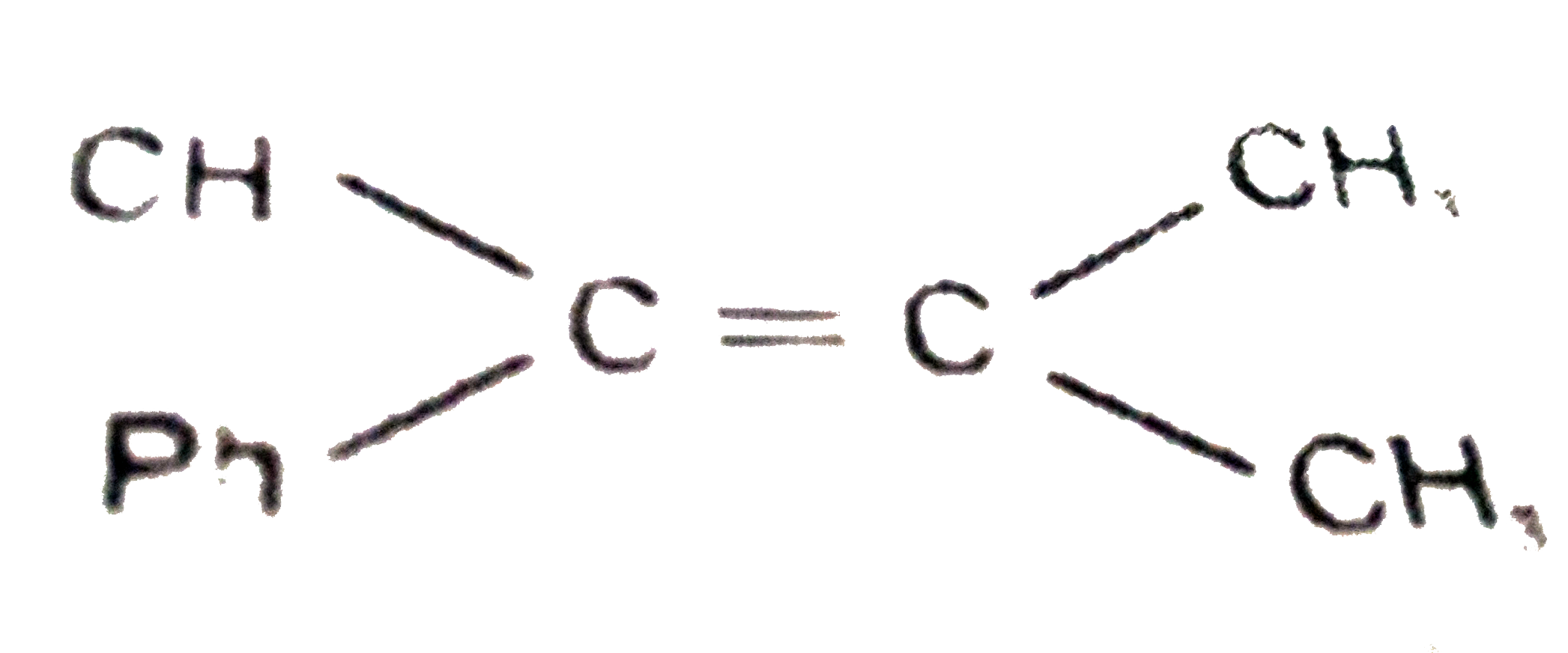Which of the following compounds will give same major product on acid catalysed hydration ?
Ph−CH3∣C∣CH3−CH=CH2
Ph−CH3∣CH−C∣CH3=CH2


The correct Answer is:A, B, C, D
To determine which of the given compounds will yield the same major product upon acid-catalyzed hydration, we will analyze each compound step by step.
Step 1: Identify the Compounds
Let’s denote the compounds as follows:
- Compound A: pH−C(CH3)2−CH=CH2
- Compound B: pH−CH−C(CH3)2−CH2
- Compound C: CH3−pH−CH=CH2
- Compound D: CH3−CH=C(CH3)−pH
Step 2: Analyze Compound A
1. Formation of Carbocation:
- Upon protonation, the double bond in Compound A will form a carbocation at the more substituted carbon due to Markovnikov's rule.
- The carbocation formed is pH−C(CH3)2−CH+.
2. Rearrangement:
- A methyl shift occurs, leading to a more stable carbocation.
- The final product after hydration will be pH−C(CH3)2−CH2OH.
Step 3: Analyze Compound B
1. Formation of Carbocation:
- Similar to Compound A, the double bond in Compound B will also form a carbocation at the more substituted carbon.
- The carbocation formed is pH−C(CH3)2−CH+.
2. Rearrangement:
- A hydride shift occurs, leading to a more stable carbocation.
- The final product after hydration will also be pH−C(CH3)2−CH2OH.
Step 4: Analyze Compound C
1. Formation of Carbocation:
- The double bond in Compound C will form a carbocation at the more substituted carbon.
- The carbocation formed is CH3−pH−CH+.
2. Rearrangement:
- A shift occurs, leading to a more stable carbocation.
- The final product after hydration will be pH−C(CH3)2−CH2OH.
Step 5: Analyze Compound D
1. Formation of Carbocation:
- The double bond in Compound D will form a carbocation at the less substituted carbon.
- The carbocation formed is CH3−CH+−C(CH3)−pH.
2. Rearrangement:
- A different rearrangement occurs, leading to a different product.
- The final product after hydration will be different from those of A, B, and C.
Conclusion
- Same Major Products: Compounds A, B, and C yield the same major product, which is pH−C(CH3)2−CH2OH.
- Different Product: Compound D yields a different product.
Final Answer
Compounds A, B, and C will give the same major product upon acid-catalyzed hydration.
Let’s denote the compounds as follows:
- Compound A: pH−C(CH3)2−CH=CH2
- Compound B: pH−CH−C(CH3)2−CH2
- Compound C: CH3−pH−CH=CH2
- Compound D: CH3−CH=C(CH3)−pH
1. Formation of Carbocation:
- Upon protonation, the double bond in Compound A will form a carbocation at the more substituted carbon due to Markovnikov's rule.
- The carbocation formed is pH−C(CH3)2−CH+.
- A methyl shift occurs, leading to a more stable carbocation.
- The final product after hydration will be pH−C(CH3)2−CH2OH.
1. Formation of Carbocation:
- Similar to Compound A, the double bond in Compound B will also form a carbocation at the more substituted carbon.
- The carbocation formed is pH−C(CH3)2−CH+.
- A hydride shift occurs, leading to a more stable carbocation.
- The final product after hydration will also be pH−C(CH3)2−CH2OH.
1. Formation of Carbocation:
- The double bond in Compound C will form a carbocation at the more substituted carbon.
- The carbocation formed is CH3−pH−CH+.
- A shift occurs, leading to a more stable carbocation.
- The final product after hydration will be pH−C(CH3)2−CH2OH.
1. Formation of Carbocation:
- The double bond in Compound D will form a carbocation at the less substituted carbon.
- The carbocation formed is CH3−CH+−C(CH3)−pH.
- A different rearrangement occurs, leading to a different product.
- The final product after hydration will be different from those of A, B, and C.
- Same Major Products: Compounds A, B, and C yield the same major product, which is pH−C(CH3)2−CH2OH.
- Different Product: Compound D yields a different product.
Compounds A, B, and C will give the same major product upon acid-catalyzed hydration.
Topper's Solved these Questions
- ORGANIC REACTION MECHANISMS - IIBOOK - RESONANCE ENGLISHCHAPTER - ORGANIC REACTION MECHANISMS - IIEXERCISE - Exercise-2 Part-4
5 Videos
- ORGANIC REACTION MECHANISMS - IIBOOK - RESONANCE ENGLISHCHAPTER - ORGANIC REACTION MECHANISMS - IIEXERCISE - Exercise-3 Part-1
20 Videos
- ORGANIC REACTION MECHANISMS - IIBOOK - RESONANCE ENGLISHCHAPTER - ORGANIC REACTION MECHANISMS - IIEXERCISE - Exercise-2 Part-2
8 Videos
- MOLE CONCEPTBOOK - RESONANCE ENGLISHCHAPTER - MOLE CONCEPTEXERCISE - ORGANIC CHEMISTRY(BASIC CONCEPTS)
27 Videos
- ORGANIC REACTION MECHANISMS-IVBOOK - RESONANCE ENGLISHCHAPTER - ORGANIC REACTION MECHANISMS-IVEXERCISE - APSP PART-3
22 Videos
Similar Questions
Knowledge Check
Which of the following compounds will give acid base reaction with RMgX?
ACH3−O∣∣C−ClBH2SCH−O∣∣C−O−HD
Which of the following reaction will not give ether as a major product?
ACH3CH2Cl+Ag2(dry)→B(CH3)3CCl+CH3CH2O−Na+→C DCH3Cl+Na+O−−CH3∣C∣CH3−CH3→
DCH3Cl+Na+O−−CH3∣C∣CH3−CH3→
The major product formed by the acid catalysed hydration of

View SolutionWhich of the following compounds will give tertiary butanol as the major product when treated with excess of MeMgBr?
View SolutionWhich of the following will give same product on ozonolysis

View SolutionWhich of the following reaction has the correct major product .
View SolutionWhich of the following hydrocarbons give same product on hydrogenation :
View SolutionWhich of the following alkenes will give same product by any method out of hydration, hydroboration-oxidation and oxymercuration-demercuration?
View Solution
